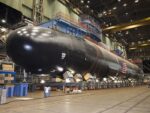Impulse Space has unveiled its new “Helios” kick stage system designed to provide rapid orbital insertion capabilities—enabling same-day delivery of payloads into precise orbits. This development marks a significant step forward in responsive space logistics and could reshape how defense and commercial actors approach satellite deployment strategies.
Helios Overview: A New Class of Orbital Transfer Vehicle
Helios is a high-performance kick stage developed by Impulse Space to serve as an orbital transfer vehicle (OTV), capable of maneuvering payloads from low Earth orbit (LEO) drop-off points to targeted operational orbits within hours. The platform is optimized for rapid-response missions and aims to address growing demand from both defense and commercial sectors for flexible and time-sensitive space deployments.
According to Impulse Space’s official release on September 17, 2025, Helios is designed with a thrust-to-weight ratio greater than 1.0 and features restartable propulsion systems. This enables multiple burns per mission—critical for deploying multiple payloads across various orbital planes or altitudes. The system supports ride-share configurations as well as dedicated missions.
Key specifications include:
- Thrust-to-weight ratio: >1.0 (enables direct injection into final orbit)
- Propulsion: Restartable chemical propulsion system
- Payload capacity: Not publicly disclosed; optimized for small to medium-class satellites
- Maneuverability: Capable of multiple burns for complex orbital insertions
Operational Relevance for Military and Dual-Use Missions
The implications of Helios extend beyond commercial applications. For military users—particularly those focused on C4ISR (Command, Control, Communications, Computers, Intelligence, Surveillance & Reconnaissance)—the ability to deploy satellites into specific orbits within hours offers substantial tactical advantages.
This capability aligns with the U.S. Department of Defense’s push toward “responsive space” concepts under initiatives such as Tactically Responsive Launch (TacRL) and the U.S. Space Force’s Operationally Responsive Space (ORS) programs. In contested environments where timing is critical—for example in response to anti-satellite threats or sudden ISR needs—the ability to rapidly reconstitute or augment orbital constellations could prove decisive.
The Helios system could also support allied nations seeking sovereign launch options without full-scale launch infrastructure by acting as an intermediary between rideshare launches and precise orbit placement.
Differentiators Compared to Other Kick Stages
The market for OTVs has grown significantly in recent years with players like Momentus (Vigoride), D-Orbit (ION), Exotrail (SpaceVan), Launcher (Orbiter), and Firefly Aerospace entering the field. However, Impulse Space claims several differentiators with Helios:
- Same-day delivery capability: Most existing OTVs require days or weeks after launch before payload deployment; Helios targets sub-24-hour timelines.
- Aggressive maneuvering profile: High thrust-to-weight enables faster transfers compared to electric propulsion-based OTVs like Momentus Vigoride.
- Simplified integration: Designed for compatibility with major launch providers including Falcon 9/Heavy (SpaceX), Vulcan Centaur (ULA), and future small-lift vehicles.
This positions Helios uniquely between high-end upper stages like Rocket Lab’s Photon and lower-thrust electric OTVs that prioritize efficiency over speed.
Status of Development and Upcoming Milestones
The company has not yet disclosed a firm launch date but stated that initial flight demonstrations are expected in late 2026 aboard a Falcon 9 rideshare mission. Ground testing of the propulsion module is reportedly underway at Impulse’s Redondo Beach facility in California.
This follows earlier progress made by Impulse on its Mira OTV—a smaller vehicle targeting longer-duration missions using more efficient propulsion systems—and aligns with the company’s broader roadmap toward building a suite of in-space mobility solutions.
The team behind Helios includes veterans from JPL/NASA propulsion programs as well as engineers previously involved in Mars EDL systems—a pedigree that suggests serious technical ambition behind the project.
Tactical Use Cases: From ISR Augmentation to Threat Mitigation
If fielded successfully at scale, Helios could enable several key military use cases:
- Tactical ISR augmentation: Deploying EO/IR or SIGINT micro-satellites over conflict zones within hours of tasking orders.
- SATCOM resilience: Rapid replenishment of damaged or jammed communications nodes in LEO/MEO constellations.
- Civil-military dual use: Disaster response support via rapid imaging satellite deployment post-earthquake/hurricane scenarios.
- Aggressive maneuvering deterrence: Ability to outpace adversary ASAT targeting timelines through unpredictable orbital insertions.
This aligns with emerging doctrines emphasizing speed-of-response over traditional massed constellations—especially relevant amid rising tensions across Indo-Pacific and Eastern European theaters where space denial threats are increasing.
The Broader Context: Responsive Launch Ecosystem Maturing
The unveiling of Helios comes amid broader maturation of the responsive launch ecosystem across NATO-aligned countries. The U.S., UK, Germany, Japan, Australia—and increasingly Ukraine—all emphasize agility in space operations through modular architectures supported by commercial partners.
This includes efforts such as Rocket Lab’s “HASTE” program for hypersonic testbed launches; Firefly Aerospace’s VICTUS NOX mission with U.S. Space Force; ABL Systems’ RS1 mobile launcher; Isar Aerospace’s Spectrum vehicle; and Sierra Nevada Corporation’s Dream Chaser cargo plane—all aiming at reducing lead time from tasking order to on-orbit presence from months down to days or even hours.
If successful in flight validation by late 2026–2027 timeframe, Helios could become a cornerstone component enabling this vision—not just as hardware but also through its software stack enabling autonomous navigation and tasking updates mid-mission via secure uplinks—a feature hinted at but not yet confirmed publicly by Impulse executives during recent interviews at SmallSat Symposium events.
Conclusion: A Potential Game-Changer If Execution Matches Ambition
The introduction of the Helios kick stage signals growing momentum toward truly responsive space operations—where timelines are measured not in weeks but hours. While much remains contingent on successful demonstration flights and scaling production capacity beyond prototypes, Impulse Space appears well-positioned technically and strategically within this evolving domain.
If it can deliver on promises around same-day delivery into custom orbits—with integration flexibility across multiple launch platforms—it may become a go-to mobility layer between terrestrial command centers and agile satellite constellations operating under increasing threat conditions globally.









